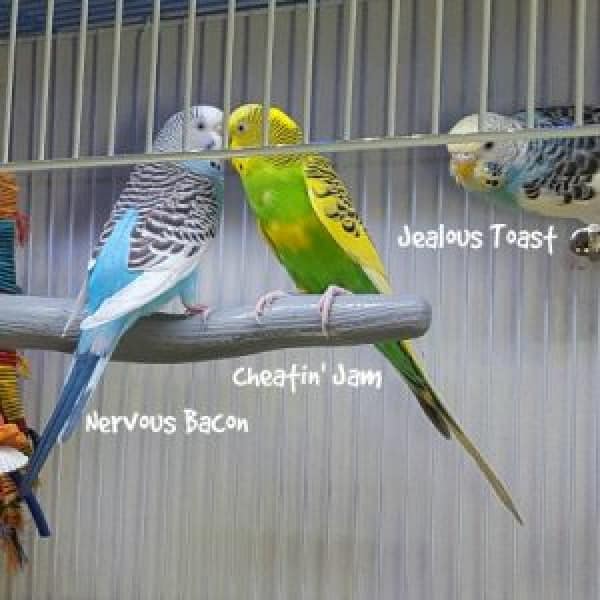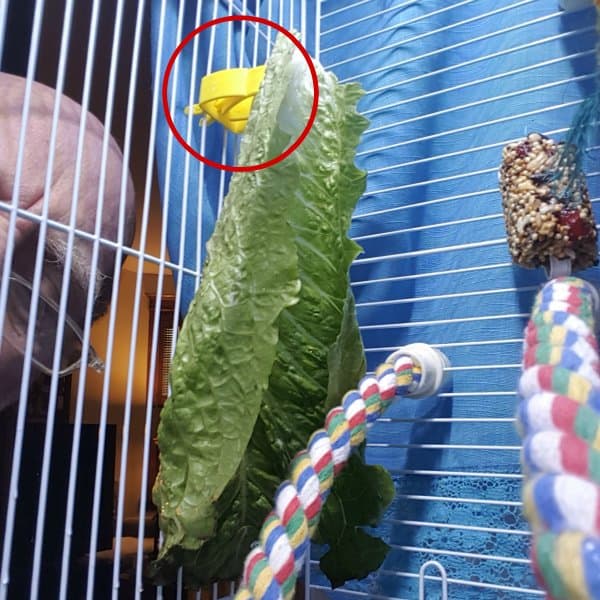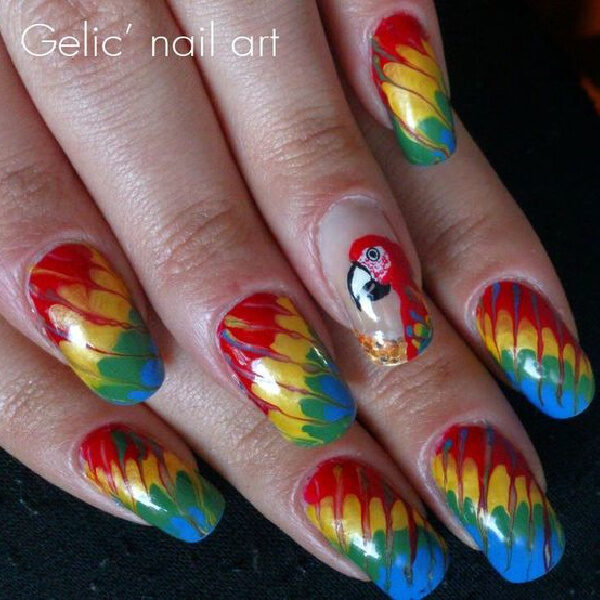
Budgie Nutrition, Cage Set Up Video & Tips
Last Updated on by Mitch Rezman
Peggie W replied – Feb 19, 8:25am
Hi, I am about to order some of the Scenic pellets for parakeets. I was just wondering how this compares to Volkman’s parakeet mix or Harrisons. I’ve been feeding my keets Volkman’s. Also, could you write more about parakeets?
No one will write about parakeets! It’s always about the larger birds. I’d like to hear more about training an older, or stubborn bird, getting them to play more. Also, more about creative cage arrangements for smaller birds.
Many cages I see on YouTube with parakeets are heartbreaking – sparsely furnished, boring. Also, seems 99% of the bird toys out there are for larger birds. Parakeets are a huge part of the market, so I’m surprised they are so ignored when it comes to toys and care advice. I’d love to hear more on this from your newsletter! Thanks for the weekly emails, I always look forward to reading them.
I’ll work up something for you Peggie – mitchr
For now
To be clear Volkman is all seed – Harrison’s and Scenic are pellets or fully engineered food. Harrison’s pellets are organic and non gmo but they only have a couple of formulations.
Scenic has more flavors and been supplying zoos for many years.
So here’s the something Peggy
When most of us hear the word parakeet we instantly think of our budgies. The reality is parakeets come in all shapes and sizes, monk parakeets a.k.a. Quaker parrots.
Mustache parakeets, Indian ringneck parakeets you get the idea.
Editor’s note: all conures are parakeets but not all parakeets are conures.
Now that we’ve gotten housekeeping out of the way let’s talk about “budgerigars”.
At a TASC meeting one night Dr. Karen Becker spoke about performing intake on a budgie in a woman who was in her late 70s or early 80s.
Working away through the traditional intake questions, when quizzed about the bird’s age the woman said 26.
Naturally, Dr. Becker replies how can you confirm this? The woman brought out the Woolworths receipt where she had originally purchased the bird confirming its age.
When Dr. Becker queried the woman as to what she attributed the birds longevity, the woman replied “I have a cup and he has a saucer of decaffeinated green tea, every day for 26 years”.
Which led to an interesting discussion by Dr. Becker about how widely tea is used in nutrition and zoos for exotic animals. But that’s another rabbit hole.
This is a first-hand tale of budgie socialization
Some of you may remember when we rescued Bacon the budgie last summer. After a couple weeks we realized that he was miserable, he was wild and it would take a long time to train him if ever. He needed a cage mate, not us.
It didn’t take us long to acquire what we thought was another boy budgie but it turned out to be a female we named Eggs. Fortunately they got along famously and would sit next to each other for hours chatting and kissing. But they still acted very skittish as Bacon would react wildly when we neared the cage which also got Eggs going.
Here we had this big beautiful Prevue flight cage and Catherine felt that the addition of another pair would round things out. We had no idea how prophetic that turned out to be.
Thank you ! I saw several things there that I know my parakeets would enjoy. I’ve been chopping their lettuce for them but I am going to start using those millet clips.
Also, the millet holder, and some of those toys. I’ve had them 3 years this spring and none of them will take a bath ! Dirty birds.
But more than that, I think they’d enjoy a bath, if’d they’d at least try it. I’m reluctant to mist them in their cage. I was worried their perches would get too wet.
Would love some advice on getting them to take a bath, for their own pleasure. Again, thank you for being so responsive, very appreciated.
Peggie
The weekend of the National Cage Bird Club show that we were helping brand Hagen bird food we were gifted a beautiful pair of budgies by none other than Jason Crean from the aforementioned TASC.
It’s been about seven weeks since these four hoodlums have been together. We made some changes to the cage. They also like millet – what bird doesn’t? We give them one millet spray in a holder every two days to share between the four of them.
Moving most of the toys to both the left and right side of the cage allows short flights of 6 to 18 inches but flights nonetheless. This solves two problems.
It ensures that they all get plenty of exercises while allowing “escape routes” when one bird gets a little over affectionate towards another – which happens a lot.
I can tell you from experience budgies are not monogamous. We’re fairly certain that Toast and Jam are brother and sister. What is even more interesting is that the head feathers on Eggs have changed dramatically making her look very similar to a relative of Toast – which is very pretty.
I’m working on getting the camera with a wider lens. The activity in this video defines their day. If one of us is standing in front of the cage they all freeze in place, but once we walk away it is a never-ending soap opera.
You can hear them talking to each other. They’re clearly communicating about “activities.” And I don’t take this lightly.
Look at this BBC video of millions of budgies in the Australian outback.
We get a mind numbing amount of phone calls at the birdie boutique asking where one can buy a “parrot that talks”
There are volumes written on how great African Grey parrots can talk and certain Cockatoos. We will always tell people it is the luck of the draw. Male cockatiel’s are generally talkers whereas female cockatiel’s are usually just chirpers. But this can vary bird to bird.
Surprisingly one of the best species of talking birds is a, you guessed it the budgie – don’t believe me? Meet Disco.
So now you know that even if Mickey Rourke feels that having a large white bird on his shoulder is cool, you can take solace in the fact that the diminutive little budgie can fend off by and out fly a hawk 10 times its size
Watch a budgie out fly a falcon
Back to the matter at hand which we call cagescaping – like landscaping but for birdcages.
When we set out to fill up the cage with toys and accessories there are certain fundamentals you always want to keep in mind. Birds will spend the majority of their time in the upper third of the cage no matter how tall the cage is.
This is where you want to offer them privacy but easy accessibility while at the same time placing perches lower in the cage avoiding poop trajectories reducing your cleaning time.
Birds interact with toys because of the need to forage, to hide behind for privacy and sometimes when you have a multi-bird case scenario is we do, Bacon for instance likes to spend time tugging on this ring toy but also acrobatically jumping through each of the hoops.
He doesn’t want to be bothered with by any other bird and as though he has his own space like you or I going to the gym.
Toys can also offer protection barriers where one bird can hide behind a toy indicating he or she wants to be left alone.
You also want to plan for jealousy and aggression. The Breakfast Club always has a minimum of two areas to acquire their basic seed diet. We have an 8 inch long horizontal Millet holder so they can all share without bumping tailfeathers.
Two sources of water, one to bathe and one to drink but is still two sources. Should one bird become protective of a feeding area as well as hanging treat bars? I also fill a snack cup with three or four nutri-berries, pulverizing them between my thumb and index finger making them highly palatable for small birds and that dish gets filled every day because of the broad spectrum of nutrition nutri-berries offer
Editor’s note: sometimes treat bars fall apart into chunks that I place on top of their regular see dishes or in treat cups around the cage. I’ll remove the treat bar fragments if they lose interest but in most cases it becomes one more pile of dust on top of the seed dish that it’s in.
One of the biggest knocks on pet bird ownership is that “birds are messy”. I can tell you from experience that the hulls of millet contain some antigravity property sending them hundreds of feet away from the cage.
bird bath with a secondary water source
If you don’t want to clean the mess every day don’t get a bird. Take four flighted budgies and a millet spray every 48 hours and you’ll understand why we keep the canister vacuum directly under the cage.
There are things that you can do to reduce your cleaning time. Most birdcages have a floor called a grate, and then a pullout refuse tray.
The problem with grates is that they get most of the poop and food particulate making them very difficult to clean. Even the best of powder coatings can come to rust after years of trying to bust off the poop you meant to clean last week.
We have always been fans of putting newspaper over the great in the newspaper in the tray. If you’re not putting newspaper over the grate the birds are walking on the grate and the poop can get stuck to it creating quite a mess to clean.
We avoid this by removing the grate altogether and lining the remaining tray with newspaper that gets replaced daily. Healthy parakeet droppings are firm little black and white balls that should not be wet. If your birds have wet droppings for long, you may need to take them to the vet.
Birds like swings. Our budgies like swings. Our Senegal likes swings. Swings should be in every cage to see if they would enjoy it.. The perch part of the swing can be made of many materials everything from wood to calcium.
In terms of perches it will always be good to have a growing type perches in highly active areas like around food dishes and entry doors.
One or two wood perches at the very least not counting the long dowel rods that probably came with the cage. If you have plastic perches you should replace with wood or rope. But I’m talking about Manzanita and coffee wood, with shapes that will challenge your bird’s feet.
You’ll notice in all of our cages we have a lot of Booda soft rope perches. They are flexible and provide an endless variety of opportunities for your bird to move about the cage on its feet which they are on 24/7 for the most part. There are those who are concerned about loose threads. All rope perches need to be inspected daily and trimmed if a loose thread shows up. Also, your budgies nails need to be watched and if too long, should be trimmed.
All of our cages also have a heated thermo perch giving the birds an opportunity to feel warm and comfy should the ambient air in our home be a little too cool.
written by mitch rezman
approved by catherine tobsing
your zygodactyl footnote
Author Profile
Latest entries
 The Traveling BirdJune 26, 2025Can You Name 5 Parrot Species That Are Living Wild in the USA?
The Traveling BirdJune 26, 2025Can You Name 5 Parrot Species That Are Living Wild in the USA? Bird BehaviorJune 26, 2025How is it Parrots Are Problem Solvers Social Animals and Even Use Tools?
Bird BehaviorJune 26, 2025How is it Parrots Are Problem Solvers Social Animals and Even Use Tools? Bird & Parrot AnatomyJune 25, 2025How a Tiny Chemical Modification Makes Parrots Nature’s Living Paintings
Bird & Parrot AnatomyJune 25, 2025How a Tiny Chemical Modification Makes Parrots Nature’s Living Paintings PigeonsJune 20, 2025How Do Parrots Thrive in Cities Outside Their Native Habitats?
PigeonsJune 20, 2025How Do Parrots Thrive in Cities Outside Their Native Habitats?
This Post Has 2 Comments
Leave a Reply
You must be logged in to post a comment.




[email protected]
26 Feb 2017I also had trouble getting my budgie to bathe- she hates misting, disdains baths in the sink and bowls of water in the cage, and is not tempted to bathe or shower with me. What eventually worked for me is the Lixit bird bath- it’s labeled as exterior mount but I keep it in the cage. It’s shallow enough for a budgie but wide enough to allow wing-washing in comfort, and the fact that the bowl screws off the base makes it easy to remove to refill or clean.
bourkebabe
28 Feb 2017Thankyou for this small bird article. I have Bourke parakeets and articles about them are very rare, too…like most smaller birds. Love to read about budgies as they were my childhood, and a bit beyond, friends. I have to agree with the “captain” in the comment below mine….my birds love the Lixit bird bath….but also their side mounted, two sided water dish. First comes a drink, then comes a bath.